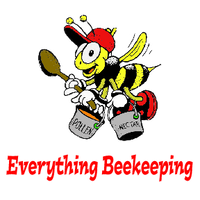Summer Pests: Identifying the Culprits in Your Beehives!
Posted by Wayne Flewelling on
🐝🔍 Summer Pests: Identifying the Culprits in Your Beehives! 🔍🐝
Hello, dedicated beekeepers and nature enthusiasts! As we embrace the warmth of summer, it's crucial to be aware of the common pests that can jeopardize the health and well-being of our beloved honeybees. Join me as we explore the world of summer pests and learn how to identify and combat these intruders!
🕷️ Varroa Mites:
Varroa mites are a notorious enemy of our precious bees. These tiny parasites attach themselves to bees and feed on their hemolymph, weakening their immune systems and transmitting viruses. Look for visible signs of infestation, such as mites on adult bees or deformed wings. Regular monitoring and timely intervention are crucial to controlling varroa mite populations and protecting your colonies.
🦋 Wax Moths:
Wax moths are unwelcome guests that can wreak havoc on your honeycomb and stored honey. The larvae of these pests tunnel through wax, creating webbing and causing damage. Keep an eye out for webbing, cocoon-like structures, or holes in your comb as signs of a wax moth infestation. Maintaining strong colonies, proper ventilation, and regular hive inspections are key to preventing and addressing these intruders.
🪲 Small Hive Beetles:
Small hive beetles may seem innocuous, but they can cause significant damage if left unchecked. They lay their eggs in beehives, and their larvae feed on honey, pollen, and brood. Look for adult beetles, slime trails, or larvae in your hive as indications of small hive beetle activity. Implementing cultural practices like reducing hive space and vigilant monitoring are effective ways to deter and control these pests.
🌞 Summer Pest Vigilance:
During the summer months, pests can multiply rapidly due to favorable conditions. Heat and humidity create an environment where pests thrive, making vigilance even more critical. Regularly inspect your beehives, paying close attention to brood frames, honey stores, and the behavior of your bees. By being proactive, you can catch pest infestations early and take appropriate measures to protect your colonies.
📚 Learning and Collaboration:
Stay informed about the biology, behavior, and control methods for each pest that poses a threat to your hives. Knowledge is your greatest ally in pest management. Consult reputable resources, books, online forums, and experienced beekeepers to expand your understanding and gain valuable insights. Collaborate with local beekeeping associations or join online communities to exchange experiences and learn from fellow beekeepers.
🛡️ Protecting Our Bees:
By familiarizing ourselves with the common pests that target beehives during the summer, we can act swiftly to protect our colonies. Regular monitoring, early detection, and the implementation of appropriate pest control measures are crucial to maintaining the health and productivity of our honeybees. Together, let's defend our buzzing friends from the threats posed by these summer pests!
🌼🐝 #ProtectTheBees #SummerPestControl #BeekeeperCommunity #Everything Beekeeping 🐝🌼
Hello, dedicated beekeepers and nature enthusiasts! As we embrace the warmth of summer, it's crucial to be aware of the common pests that can jeopardize the health and well-being of our beloved honeybees. Join me as we explore the world of summer pests and learn how to identify and combat these intruders!
🕷️ Varroa Mites:
Varroa mites are a notorious enemy of our precious bees. These tiny parasites attach themselves to bees and feed on their hemolymph, weakening their immune systems and transmitting viruses. Look for visible signs of infestation, such as mites on adult bees or deformed wings. Regular monitoring and timely intervention are crucial to controlling varroa mite populations and protecting your colonies.
🦋 Wax Moths:
Wax moths are unwelcome guests that can wreak havoc on your honeycomb and stored honey. The larvae of these pests tunnel through wax, creating webbing and causing damage. Keep an eye out for webbing, cocoon-like structures, or holes in your comb as signs of a wax moth infestation. Maintaining strong colonies, proper ventilation, and regular hive inspections are key to preventing and addressing these intruders.
🪲 Small Hive Beetles:
Small hive beetles may seem innocuous, but they can cause significant damage if left unchecked. They lay their eggs in beehives, and their larvae feed on honey, pollen, and brood. Look for adult beetles, slime trails, or larvae in your hive as indications of small hive beetle activity. Implementing cultural practices like reducing hive space and vigilant monitoring are effective ways to deter and control these pests.
🌞 Summer Pest Vigilance:
During the summer months, pests can multiply rapidly due to favorable conditions. Heat and humidity create an environment where pests thrive, making vigilance even more critical. Regularly inspect your beehives, paying close attention to brood frames, honey stores, and the behavior of your bees. By being proactive, you can catch pest infestations early and take appropriate measures to protect your colonies.
📚 Learning and Collaboration:
Stay informed about the biology, behavior, and control methods for each pest that poses a threat to your hives. Knowledge is your greatest ally in pest management. Consult reputable resources, books, online forums, and experienced beekeepers to expand your understanding and gain valuable insights. Collaborate with local beekeeping associations or join online communities to exchange experiences and learn from fellow beekeepers.
🛡️ Protecting Our Bees:
By familiarizing ourselves with the common pests that target beehives during the summer, we can act swiftly to protect our colonies. Regular monitoring, early detection, and the implementation of appropriate pest control measures are crucial to maintaining the health and productivity of our honeybees. Together, let's defend our buzzing friends from the threats posed by these summer pests!
🌼🐝 #ProtectTheBees #SummerPestControl #BeekeeperCommunity #Everything Beekeeping 🐝🌼
